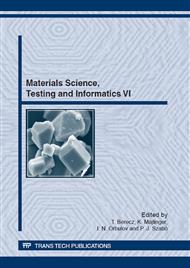[1]
White S.R., Sottos N.R., Geubelle P.H., Moore J.S., Kessler M.R., Sriram S.R., Brown E.N., Viswanathan S.: Autonomic healing of polymer composites, Nature. 409 (2001) 794-797.
DOI: 10.1038/35057232
Google Scholar
[2]
Murphy E.B., Wudl F.: The world of smart healable materials. Progress in Polymer Science. 35 (2010) 223-251.
DOI: 10.1016/j.progpolymsci.2009.10.006
Google Scholar
[3]
Blaiszik B.J., Kramer S.L.B., Olugebefola S.C., Moore J.S., Sottos N.R., White S.R.: Self-healing polymers and composites. Annual Review of Materials Research. 40 (2010) 179-211.
DOI: 10.1146/annurev-matsci-070909-104532
Google Scholar
[4]
Yuan Y.C., Yin T., Rong M.Z., Zhang M.Q.: Self healing in polymers and polymer composites. Concepts, realization and outlook: A review. Express Polymer Letters. 2 (2008) 238-250.
DOI: 10.3144/expresspolymlett.2008.29
Google Scholar
[5]
Yuan Y.C., Rong M.Z., Zhang M.Q., Chen J., Yang G.C., Li X.M.: Self-healing polymeric materials using epoxy/mercaptan as the healant. Macromolecules. 41 (2008) 5197-5202.
DOI: 10.1021/ma800028d
Google Scholar
[6]
Yuan L., Liang G. -Z., Lie J. -Q.: Synthesis and characterization of microencapsulated dicyclopentadiene with melamine–formaldehyde resins. Colloid Polymer Science. 285 (2007) 781-791.
DOI: 10.1007/s00396-006-1621-5
Google Scholar
[7]
Brown E.N., Kessler M.R., Sottos N.R., White S.R.: In situ poly(urea-formaldehyde) microencapsulation of dicyclopentadiene. Journal of Microencapsulation. 20 (2003) 719-730.
DOI: 10.1080/0265204031000154160
Google Scholar
[8]
Yin T., Rong M.Z., Zhang M.Q., Yang G.C.: Self-healing epoxy composites – Preparation and effect of the healant consisting of microencapsulated epoxy and latent curing agent. Composites Science and Technology. 67 (2007) 201-212.
DOI: 10.1016/j.compscitech.2006.07.028
Google Scholar
[9]
Yuan Y.C., Rong M.Z., Zhang M.Q.: Preparation and characterization of microencapsulated polythiol. Polymer. 49 (2008) 2531-2541.
DOI: 10.1016/j.polymer.2008.03.044
Google Scholar
[10]
Blaiszik B.J., Caruso M.M., McIlroy D.A., Moore J.S., White S.R., Sottos N.R.: Microcapsules filled with reactive solutions for self-healing materials. Polymer. 50 (2009) 990-997.
DOI: 10.1016/j.polymer.2008.12.040
Google Scholar
[11]
Frere W., Danicher L., Gramain P.: Preparation of polyurethane microcapsules by interfacial polycondensation. European Polymer Journal. 34 (1998) 193-199.
Google Scholar
[12]
Yuan L., Liang G., Xie J., Li L., Guo J.: Preparation and characterization of poly(urea-formaldehyde) microcapsules filled with epoxy resins. Polymer. 47 (2006) 5338-5349.
DOI: 10.1016/j.polymer.2006.05.051
Google Scholar
[13]
Szabó T., Molnár-Nagy L., Bognár J., Nyikos L., Telegdi J.: Self-healing microcapsules and slow release microspheres in paints. Progress in Organic Coatings. 72 (2011) 52-57.
DOI: 10.1016/j.porgcoat.2011.03.014
Google Scholar


